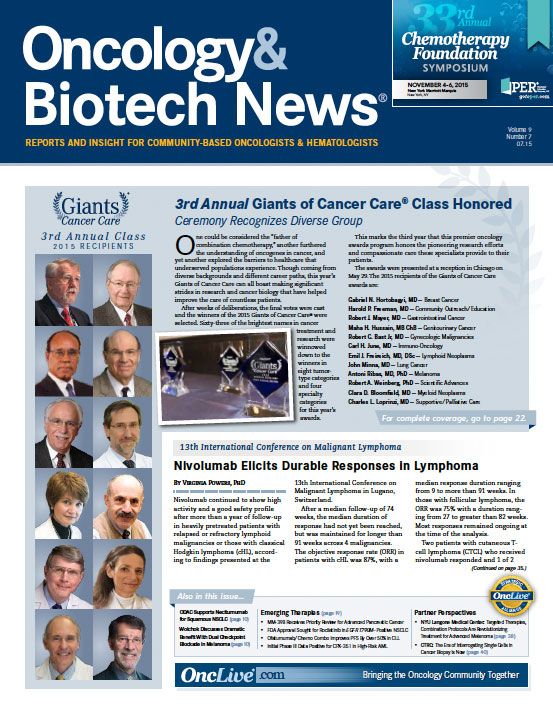Publication
Article
Oncology & Biotech News
Targeted Therapies, Combination Protocols Are Revolutionizing Treatment for Advanced Melanoma
Author(s):
Melissa A. Wilson, MD, PhD, discusses how targeted therapies and combination protocols are revolutionizing the treatment paradigm of advanced melanoma.
Melissa A. Wilson, MD, PhD
Assistant Professor,
Department of Medicine
Division of Medical Oncology
The treatment landscape for advanced melanoma is expanding dramatically. Just a few years ago, we had little to offer patients. Nothing showed a survival benefit. But over the past few years, the FDA has approved a handful of new agents that improve treatment response and overall and progression-free survival. Although a number of patients have had amazing responses to immunotherapy, there still are a number of them who do not respond to these agents. In addition, targeted therapy can only be used in select patient populations, and responses are not as durable as desired. Thankfully, preclinical research into novel agents and clinical trials are flourishing.
Advances in molecular biology are leading the way in targeting multiple signals in the pathways to treatment resistance. Precision medicine is now on the horizon as bench researchers investigate better biomarkers that can offer better patient selection for specific agents and combinations.
At the Laura and Isaac Perlmutter Cancer Center at NYU Langone Medical Center, we have a very active group of researchers focusing both on preclinical work and clinical trials. I am the proud recipient of the Melanoma Research Alliance and ASCO’s Young Investigator Awards.
One of the grants will focus on developing new strategies to overcome resistance to treatments targeted at inhibiting BRAF mutations that commonly cause certain cancers like melanoma. This direction is critically important because approximately half of patients with melanoma have an activating BRAF V600 mutation. Even though new therapies that target BRAF became FDA approved in 2013, resistance occurs after approximately 12 months of treatment with these agents.
Through this grant, we also will investigate in a multiphase trial whether resistance to targeted therapy can be overcome by adding an antibody targeting ERBB3 to BRAF and MEK inhibitors. This trial will examine the safety, tolerability, and preliminary efficacy of the combination of dabrafenib, trametinib, and MM-121. We will particularly focus on progression-free survival, objective response rate, overall survival, and adverse events.
Part and parcel of the study will be a comprehensive review of pre- and posttreatment tumor serial biopsies. MM-121 is a fully human anti-ERBB3 monoclonal antibody. Additionally, we hope to learn whether specific biomarkers can help to better identify a subset of patients most likely to benefit from the combination of targeted therapies. Thus, we will be able to offer patients more personalized treatment recommendations up front.
Dabrafenib, a small-molecule, selective BRAF inhibitor, and trametinib, a small-molecule, selective inhibitor of MEK1 and MEK2, were first approved by the FDA as single agents for advanced melanoma in early 2013. Last year, the FDA approved each drug for combo regimens.
Currently, I am the only researcher looking at the addition of the ERBB3 antibody to combat inhibition, while a number of fellow researchers are evaluating ways to overcome resistance to BRAF/ MEK inhibition.
A second area of my research concerns developing treatment strategies for specific melanoma populations, especially those with wildtype melanoma—in other words, those without BRAF, NRAS, and KIT somatic mutations. Once appropriate funding is secured, I will pursue this course of research, potentially opening up the development of novel therapies and clinical trials for the wild-type melanoma patient population.
This past April, researchers presented findings at the AACR Annual Meeting from two key melanoma trials. In the head-to-head randomized phase III KEYNOTE 006 trial presented at AACR, investigators compared pembrolizumab with ipilimumab, finding that the PD-1 inhibitor pembrolizumab extended progression-free survival and overall survival with fewer systemic side effects than the CTLA-4 inhibitor ipilimumab, the current standard of care. Based on this trial, the drug manufacturer, Merck, plans to secure FDA approval of pembrolizumab for frontline, single-agent therapy for advanced melanoma.
A phase I trial, also presented this past at AACR, evaluated ipilimumab and the PD-1 inhibitor nivolumab in combination, testing different doses and combinations. It showed impressive results. In the trial arm of patients getting concurrent dosing, 1-year overall survival was 85% and two-year survival was 79%. Yet even though concurrent dosing achieved far better outcomes, investigators remain concerned about toxicities, largely gastrointestinal and liver complications. Clearly, this is an exciting time for melanoma research and development. For example, we know for a fact that aberrant intracellular signaling pathways and cell cycle disruption permit melanoma to progress. As we continue to better understand immune biology and its role in melanoma and other tumor types, we may soon be able to screen for many more biomarkers in the upfront setting, and immediately use agents most likely to generate a response. New knowledge about the many different mechanisms involved in resistance will lead to additional targeted therapies in the varied signaling pathways. New combinations are being tested in scores of clinical trials. I am hopeful that we will have even more to offer patients as results become available.










